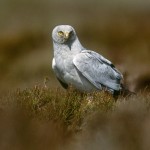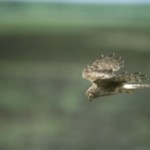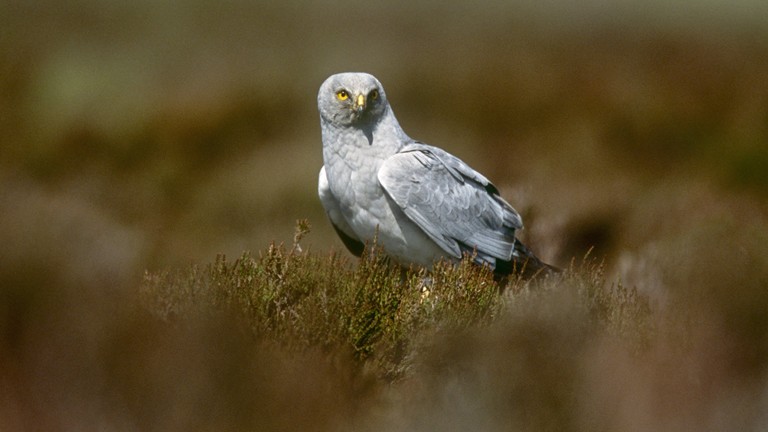FIRST CROSS-BORDER PROJECT LAUNCHED TO SAVE HEN HARRIERS
FIRST CROSS-BORDER PROJECT LAUNCHED TO SAVE HEN HARRIERS
A new European Union-supported project aims to achieve a secure and sustainable future for one of our most threatened birds of prey: the hen harrier.
Focusing on seven sites designated as nesting sites under the European Union Birds Directive for hen harriers in northern England, and southern and eastern Scotland, the European-funded Hen Harrier LIFE+ Project is an ambitious five-year programme of direct conservation action, community engagement, and awareness-raising measures.

In historical times the hen harrier was a widespread and familiar bird in the uplands of Britain. However by 1900, Victorian persecution, including that linked to driven-grouse shooting, had driven this bird of prey to extinction as a breeding species on the British mainland. Although the bird has clawed back some of its lost ground, its diet of birds and small mammals, including red grouse, brings this raptor into conflict with man, despite special legal protection. This is especially true in parts of northern England, and southern, central and eastern Scotland where land management for driven grouse shooting is most intensive.
Between 2004 and 2010 there was an 18 per cent decline in the UK hen harrier population (20 per cent in Scotland), according to the National Hen Harrier Survey. Whilst this year was good for hen harriers, productivity in places such as Langholm Moor Demonstration Project where 46 young were fledged from 12 nests, largely due to high vole numbers. Hen harriers continue to face serious threats. For example, in June this year two orphaned hen harrier chicks had to be hand reared by wildlife experts after the female bird disappeared (feared shot), in East Ayrshire.
Last year, hen harriers suffered their worst breeding season in England in decades failing to rear a single chick anywhere in England. While they fared slightly better with four nests in England in 2014, natural deaths and the sudden, unexplained disappearances of three satellite-tagged birds, mean that only nine of the 16 chicks fledged are thought to still be alive, just a few months after leaving the nest.

Blánaid Denman is the Hen Harrier LIFE+ Project manager. Commenting on the launch of the project, she said: “Hen harriers are in dire straits. Numbers are declining dramatically.
“The cross-border project provides a huge boost to our efforts to monitor and protect hen harriers. Working together with volunteers and other organisations, we’ll have more eyes and ears on the hills than ever before, using satellite tagging, winter roost monitoring and nest protection to deter persecution, identify the important areas for these birds and highlight where they’re most at risk.”
The project combines two vital strands: practical conservation (protecting them here and now); and awareness-raising and education (protecting them for future generations).
Blánaid Denman added: “The project is not about RSPB fixing things on our own but about bringing together a whole conservation community, from organisations to individuals, working together to secure a future for hen harriers in our uplands.
“Building on the success of our award-winning Skydancer Project in England, this new project will enable us to share the stories of these remarkable birds with a wider audience than ever before, working with schools and community groups on the ground and allowing people to follow tagged birds online to see where they go.”
The Hen Harrier LIFE+ Project also aims to work progressively with landowners and the shooting community, championing best practice where it occurs. It will link up and support the work of the PAWS Raptor Group “Heads Up for Hen Harriers” project, which includes Scottish Government, Scottish Natural Heritage, conservation and landowning interests.
Blánaid added: “We’ve already been doing some great stuff with gamekeeping students at colleges like Askham Bryan College in York. Now we want to build on this, working not just with students but with professional gamekeepers and landowners who like us, want to see a diverse and species-rich upland landscape protected for generations to come.”
Professor Des Thompson, Principal Adviser on Biodiversity in Scottish Natural Heritage, commented: “In parts of the UK the state of the hen harrier population is perilous. This collaborative project offers a lifeline in securing key evidence on what is working well and badly for these birds.”
Over the last 18 months, Defra have been consulting with RSPB and other stakeholders to draft an emergency recovery plan for hen harriers in England. While a final plan is still to be agreed, the initial draft has received widespread support from the shooting community. The Hen Harrier LIFE Project puts into action elements of the plan needed to achieve population recovery for hen harriers, by helping with the satellite tracking, monitoring of breeding and winter roost sites, and promotion of diversionary feeding, which will be needed to tackle illegal persecution.
The RSPB hope that the Hen Harrier LIFE project will be supported by Defra and stakeholders doing their bit, by providing the additional funding and support necessary for an effective species recovery plan.
For more information visit: The RSPB
Help save the Hen Harrier – sign the petition.

